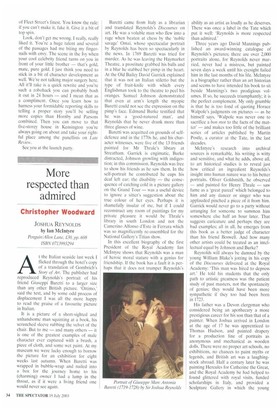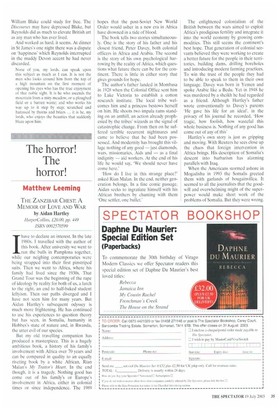More respected than admired
Christopher Woodward
JOSHUA REYNOLDS by Ian McIntyre Penguin/Allen Lane, £30, pp. 608 ISBN 0713993294 At the Italian seaside last week I flicked through the hotel's copy of a translation of Gombrich's Story of Art. The publisher had reproduced Reynolds's portrait of his friend Giuseppi Baretti to a larger size than any other British picture. 'Ottimo,' said the text, and by some odd process of displacement I was all the more happy to read the praise of a favourite picture in Italian.
It is a picture of a short-sighted and unhandsome man squinting at a book, his scrunched sleeve rubbing the velvet of the chair. But to me — and many others — it is one of the greatest examples of male character ever captured with a brush, a piece of cloth, and some wet paint. At my museum we were lucky enough to borrow the picture for an exhibition for eight weeks last autumn. When Baretti was wrapped in bubble-wrap and nailed into a box for the journey home to his (charming) owner I had a lump in the throat, as if it were a living friend one would never see again. Baretti came from Italy as a librarian and translated Reynolds's Discourses on art. He was a voluble man who flew into a rage when beaten at chess by the 'noble savage' Omai, whose spectacular portrait by Reynolds has been so spectacularly in the news. In 1769 Baretti was tried for murder. As he was leaving the Haymarket Theatre, a prostitute grabbed his balls and in a blur he stabbed her pimp in the heart. At the Old Bailey David Garrick explained that it was not an Italian stiletto but the type of fruit-knife with which every Englishman took to the theatre to peel his oranges. Samuel Johnson demonstrated that even at arm's length the myopic Baretti could not see the expression on the pimp's face. Edmund Burke testified that he was a 'good-natured man', and Reynolds that he never drank more than three glasses of wine.
Baretti was acquitted on grounds of selfdefence and in the 1770s he, and his character witnesses, were five of the 13 friends painted for Mr Thrale's library at Streatham. Garrick is engimatic, Burke distracted, Johnson growling with indigestion; in this commission, Reynolds was free to show his friends as he saw them. In the self-portrait he contributed he cups his deaf left ear; the disability — the consequence of catching cold in a picture gallery on the Grand Tour — was a useful device to ignore a sitter's suggestion about the true colour of her eyes. Perhaps it is shamefully insular of me, but if I could reconstruct any room of paintings for my private pleasure it would be Thrale's library in south London and not the Camerino Alfonso d'Este in Ferrara which was so magnificently re-assembled for the National Gallery's Titian show.
In this excellent biography of the first President of the Royal Academy Ian McIntyre shows that Reynolds was a man of heroic moral stature with a genius for friendship. If the book has a fault it is perhaps that it does not trumpet Reynolds's ability as an artist as loudly as he deserves. There was once a label in the Tate which put it well: 'Reynolds is more respected than admired.'
Three years ago David Mannings published an award-winning catalogue of Reynolds's pictures; there are over 2,000 portraits alone, for Reynolds never married, never had a mistress, but painted seven days a week until his eyesight failed him in the last months of his life. McIntyre is a biographer rather than an art historian and seems to have intended his book to sit beside Mannings's two prodigious volumes. If so, he succeeds triumphantly; it is the perfect complement. My only grumble is that he is too fond of quoting Horace Walpole's judgments on pictures — as he himself says, 'Walpole was never one to sacrifice a bon mot to the facts of the matter' — and makes too little of the brilliant series of articles published by Martin Postle, a curator at the Tate, in the last decades.
McIntyre's research into archival sources is remarkable, his writing is witty and sensitive, and what he adds, above all, to art historical studies is to reveal just how critical an ingredient Reynolds's insight into human nature was to his better portraits. Oliver Goldsmith, he observed — and painted for Henry Thrale — saw fame as a 'great parcel' which belonged to him and any dancer or singer who was applauded pinched a piece of it from him. Garrick would never go to a party without arranging for someone to summon him somewhere else half an hour later. That suggests caricature and perhaps they are had examples; all in all, he emerges from this book as a better judge of character than his friend Boswell. And how many other artists could be treated as an intellectual equal by Johnson and Burke?
Reynolds will always be damned by the young William Blake's jotting in his copy of the Discourses delivered at the Royal Academy: 'This man was hired to depress art.' He told his students that the only path to artistic greatness was the patient study of past masters, not the spontaneity of genius; they would have been more sympathetic if they too had been born in 1723.
His father was a Devon clergyman who considered being an apothecary a more prestigious career for his son than that of a painter. When Joshua arrived in London at the age of 17 he was apprenticed to Thomas Hudson, and painted drapery for a production line of portraits as anonymous and mechanical as wooden dolls. There were no proper art schools, no exhibitions, no chances to paint myths or legends, and British art was a laughingstock abroad. Half a century later he was painting Hercules for Catherine the Great, and the Royal Academy he had helped to found glittered with royal visits, funded scholarships in Italy, and provided a Sculpture Gallery in which the young
William Blake could study for free. The Discourses may have depressed Blake, but Reynolds did as much to elevate British art as any man who has ever lived.
And worked as hard, it seems. At dinner in St James's one night there was a dispute on 'happiness' which Reynolds interrupted in the muddy Devon accent he had never discarded.
None of you, my lords, can speak upon this subject as much as I can. It is not the man who looks around him from the top of a high mountain on the first moment of opening his eyes who has the true enjoyment of that noble sight. It is he who ascends the mountain from a miry meadow, or a ploughed field or a barren waste; and who works his way up to it step by step; scratched and harassed by thorns and briars ... it is he. my lords, who enjoys the beauties that suddenly blaze upon him.



























































 Previous page
Previous page